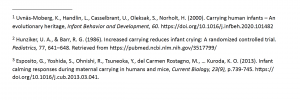Australian parents report that a high number of babies experience fussy periods, especially during the first three months. However, some babies can be more unsettled than average. While this advice isn’t intended to replace guidance from a health professional, babywearing can be one of the practical strategies for managing caregiving with an unsettled baby.
What is Babywearing?
Babywearing is a general term for the practice of carrying babies close against a caregiver’s body with the use of a carrier or similar device. Caregivers have a variety of options when babywearing, including commercially-made structured carriers, woven wraps, and ring slings. For the purpose of this article, I’ll use the term carriers to include all options.
Babies can be worn by anyone! Mums, dads, grandparents, even child care workers can benefit from using a baby carrier. Any family member may find baby wearing a useful way to assist by caring for the baby.
Trained babywearing consultants can assist with fitting and safety, as well as recommend types of carriers for the comfort of both caregiver and infant.
How can babywearing help during infancy and beyond?
Babywearing is useful in a variety of ways. Many parents struggle to prepare food, clean the house, or hang out washing while holding a baby who cries whenever they’re put down or who only naps for short periods of time frequently throughout the day. A secure wrap, carrier or sling can provide caregivers with the ability to complete household tasks with their hands free, to move around while baby sleeps, or to engage with older children while carrying the baby.
Some babies dislike being placed separately in prams, car seats, or placed on mats on the floor, and babywearing can mean that baby can move around with the caregiver as they attend to tasks in and out of the home. Many babies enjoy being able to look around at the world around them, and babywearing can provide opportunities for sensory stimulation which supports baby’s neurodevelopment. Babywearing also assists with the development of proprioceptive and vestibular systems, and can be used as a substitute for tummy time for developing strength in infant’s neck and back. Care does need to taken with wearing ergonomic carriers that support the natural development of baby’s spine, hips, and neck.
Additionally, infants who were carried were more likely to be breastfed for longer (when carried frequently by breastfeeding mothers), and developed greater vocalisations within the first year as a result of increased exposure to parent speech compared to babies placed in strollers facing away from their parents.
Can babywearing help infant development and mental health?
There is limited scientific evidence to support babywearing as a mental health intervention, but some recent research has shown promising results.
Skin to skin contact is recommended immediately after birth, and repeatedly for premature babies – this is known as kangaroo care – and research has demonstrated the positive physiological outcomes. The neurochemical oxytocin is released through skin contact, which reduces cortisol, decreases anxiety and stress, and even reduces the subjective experience of pain (for example after a heel prick test). Babywearing newborns, including those born prematurely, can assist with providing this skin to skin contact, although care needs to be taken with using an appropriate sling or wrap when premature babies are very small. Ongoing babywearing throughout infancy can contribute to many of these beneficial effects, even when clothing reduces the amount of direct skin-to-skin contact.
Most importantly, the closeness offered by babywearing can assist with bonding between infant and caregiver, and improve parental responsiveness which means that babies can signal less to have their needs met, for example for feeding and sleeping, which consequently reduces the amount of time babies spend crying by up to 43% less.
The gentle movement of being worn on a caregivers’ chest provides infants with a calm and gentle environment – they feel safe when held close to the caregiver, they can hear the heartbeat which is reassuring, and the gentle pressure of the carrier regulates early newborn reflexes. This can be particularly helpful for settling babies to sleep, or during peak crying times, such as the early evenings. Research suggests that babies cry less, their heart rate decreases, and they settle more quickly when caregivers stand and walk around than when caregivers try to settle an infant when seated and still.
The perinatal period is one of transitions, joys, and challenges. As always, at Spencer Health we are here to support you and your family. So please reach out to our friendly team.

